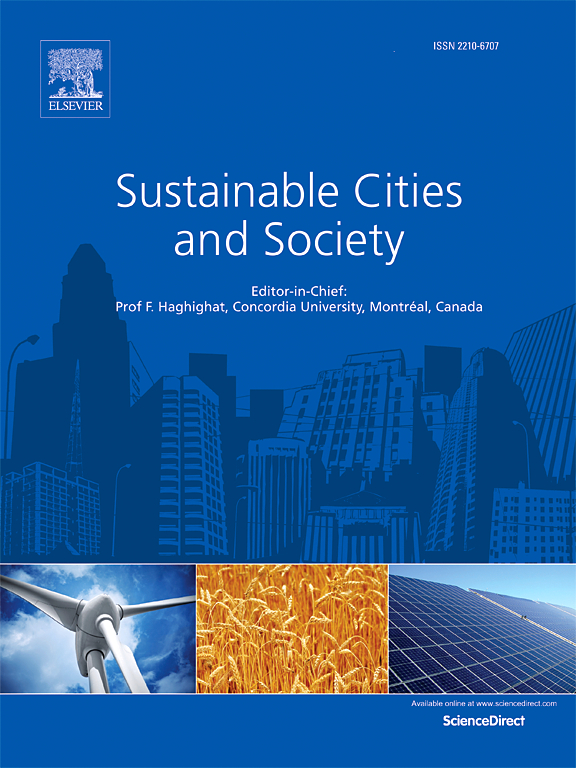A novel multi-scale deep learning framework for adaptive urban expansion simulation
IF 10.5
1区 工程技术
Q1 CONSTRUCTION & BUILDING TECHNOLOGY
引用次数: 0
Abstract
Unplanned urban sprawl can cause environmental degradation, infrastructural overload, and a diminished quality of life. Consequently, accurate urban expansion prediction models are vital for guiding sustainable city development and aligning policy decisions with long-term community needs. Current urban expansion simulation model often struggles with rigid neighbourhood definitions and static factor weighting in conventional Cellular Automata (CA) models, causing inaccuracies in capturing non-linear, multi-scale dynamics. To address these limitations, we propose an enhanced U-Net++–based framework that adaptively integrates attention mechanisms and autoregressive CA simulation. Tested on Changsha city’s multi-source spatiotemporal data from 2010 to 2022, our model achieved an Overall Accuracy of 0.87 and a Figure of Merit of 0.90, surpassing traditional methods in both quantitative metrics and visual coherence. By leveraging multi-scale convolutional features and attention-driven factor weighting, this approach effectively addresses the challenges of multi-scale and spatiotemporal heterogeneity. Furthermore, its end-to-end design allows for adaptive optimization of the entire prediction process, yielding more coherent and robust urban expansion forecasts. Moving forward, integrating wider socio-political drivers and policy constraints can further enhance the model’s practicality for sustainable urban development, ensuring that city growth management aligns with environmental goals and community well-being. This modelling framework is applicable to predict any urban setting globally.
一种新的多尺度深度学习框架用于自适应城市扩展模拟
无计划的城市扩张会导致环境恶化、基础设施超载和生活质量下降。因此,准确的城市扩张预测模型对于指导可持续城市发展和使政策决策与长期社区需求保持一致至关重要。当前的城市扩张模拟模型经常与传统元胞自动机(CA)模型中的刚性邻里定义和静态因子加权作斗争,导致在捕获非线性、多尺度动态时不准确。为了解决这些限制,我们提出了一个增强的基于U-Net++的框架,该框架自适应地集成了注意机制和自回归CA模拟。通过对长沙市2010 - 2022年多源时空数据的测试,该模型的总体准确率为0.87,优度系数为0.90,在定量指标和视觉一致性方面均优于传统方法。该方法利用多尺度卷积特征和注意力驱动因子加权,有效地解决了多尺度和时空异质性的挑战。此外,它的端到端设计允许对整个预测过程进行自适应优化,从而产生更加连贯和稳健的城市扩张预测。展望未来,整合更广泛的社会政治驱动因素和政策制约因素,可以进一步增强该模式在可持续城市发展方面的实用性,确保城市增长管理与环境目标和社区福祉保持一致。该模型框架适用于全球任何城市环境的预测。
本文章由计算机程序翻译,如有差异,请以英文原文为准。
求助全文
约1分钟内获得全文
求助全文
来源期刊

Sustainable Cities and Society
Social Sciences-Geography, Planning and Development
CiteScore
22.00
自引率
13.70%
发文量
810
审稿时长
27 days
期刊介绍:
Sustainable Cities and Society (SCS) is an international journal that focuses on fundamental and applied research to promote environmentally sustainable and socially resilient cities. The journal welcomes cross-cutting, multi-disciplinary research in various areas, including:
1. Smart cities and resilient environments;
2. Alternative/clean energy sources, energy distribution, distributed energy generation, and energy demand reduction/management;
3. Monitoring and improving air quality in built environment and cities (e.g., healthy built environment and air quality management);
4. Energy efficient, low/zero carbon, and green buildings/communities;
5. Climate change mitigation and adaptation in urban environments;
6. Green infrastructure and BMPs;
7. Environmental Footprint accounting and management;
8. Urban agriculture and forestry;
9. ICT, smart grid and intelligent infrastructure;
10. Urban design/planning, regulations, legislation, certification, economics, and policy;
11. Social aspects, impacts and resiliency of cities;
12. Behavior monitoring, analysis and change within urban communities;
13. Health monitoring and improvement;
14. Nexus issues related to sustainable cities and societies;
15. Smart city governance;
16. Decision Support Systems for trade-off and uncertainty analysis for improved management of cities and society;
17. Big data, machine learning, and artificial intelligence applications and case studies;
18. Critical infrastructure protection, including security, privacy, forensics, and reliability issues of cyber-physical systems.
19. Water footprint reduction and urban water distribution, harvesting, treatment, reuse and management;
20. Waste reduction and recycling;
21. Wastewater collection, treatment and recycling;
22. Smart, clean and healthy transportation systems and infrastructure;
 求助内容:
求助内容: 应助结果提醒方式:
应助结果提醒方式:


